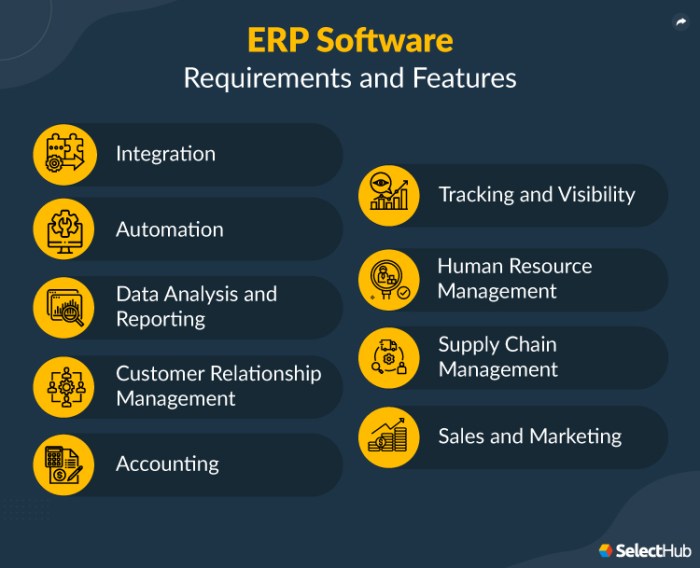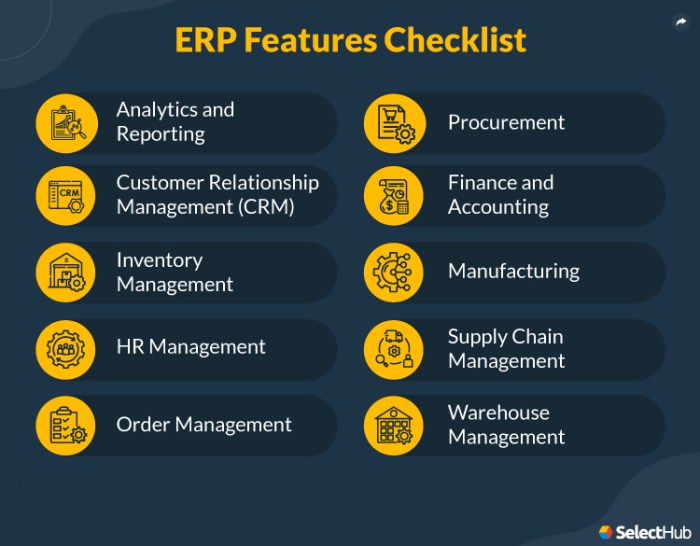Choosing the right ERP software is a critical decision for any business, as it can significantly impact operational efficiency, financial performance, and customer satisfaction. Key features to consider when evaluating ERP software options include functionality, scalability, user experience, security, and cost.
A comprehensive evaluation process should delve into each of these areas to ensure the selected software aligns with your specific business needs and long-term growth objectives. Understanding the core modules, integration capabilities, customization options, user interface, security measures, and cost implications will help you make an informed decision that maximizes value and minimizes risk.
User Experience and Training: Key Features To Consider When Evaluating ERP Software Options

A user-friendly interface and comprehensive training materials are crucial for maximizing the value of your ERP system. When evaluating ERP software options, it is essential to assess the user experience and the availability of training resources.
User Interface and Navigation
The user interface (UI) of an ERP system should be intuitive and easy to navigate. A well-designed UI will streamline workflows, improve user adoption, and reduce the likelihood of errors. Key factors to consider include:
- Intuitive Design: The UI should be visually appealing and organized in a way that makes sense to users. Familiar icons and consistent layouts can help users quickly find the information they need.
- Clear Data Visualization: Data should be presented in a clear and concise manner, using charts, graphs, and dashboards to provide insights at a glance. The ability to customize dashboards and reports is also valuable.
- User-Friendly Features: The system should offer features that make it easy for users to perform common tasks, such as entering data, generating reports, and approving requests. For example, drag-and-drop functionality and automated workflows can significantly improve efficiency.
Training Materials and Support
Comprehensive training materials are essential for helping users learn how to use the ERP system effectively. High-quality training should cover all aspects of the system, from basic functionality to advanced features.
- Online Resources: The vendor should provide a variety of online resources, such as tutorials, videos, and FAQs. These resources should be readily accessible and updated regularly.
- Documentation and User Guides: Thorough documentation and user guides are crucial for providing detailed instructions and reference materials. These documents should be well-organized and easy to navigate.
- Support Options: The vendor should offer a range of support options, including live chat, phone support, and email assistance. The support team should be responsive and knowledgeable, providing timely and effective solutions to user inquiries.
Security and Compliance

In today’s digital landscape, security and compliance are paramount considerations when evaluating ERP software options. Your business data is sensitive and needs robust protection, and you must comply with relevant regulations to avoid penalties and maintain customer trust.
An ERP system holds critical business data, including customer information, financial records, and operational processes. This makes it a prime target for cyberattacks. Therefore, it’s essential to understand the security measures offered by different ERP vendors and how they ensure compliance with industry standards.
Data Encryption
Data encryption is a fundamental security measure that safeguards sensitive information by converting it into an unreadable format. It ensures that even if unauthorized individuals gain access to your data, they cannot decipher it.
- Encryption at rest: This protects data stored on servers and databases. It’s typically implemented using encryption algorithms like AES-256.
- Encryption in transit: This protects data as it moves between systems, such as during data transfers over the internet. SSL/TLS protocols are commonly used for this purpose.
Access Controls
Access controls are essential for limiting access to your ERP system and its data based on user roles and permissions. This prevents unauthorized individuals from accessing sensitive information.
- Role-based access control (RBAC): This assigns different access levels to users based on their job roles. For example, sales personnel might have access to customer data, while finance personnel might have access to financial records.
- Multi-factor authentication (MFA): This adds an extra layer of security by requiring users to provide multiple forms of authentication, such as a password and a one-time code, before granting access.
- Audit trails: These track all user activity within the ERP system, allowing you to identify potential security breaches and investigate suspicious activity.
Disaster Recovery Plans, Key features to consider when evaluating ERP software options
Disaster recovery plans are crucial for ensuring business continuity in the event of a system failure, natural disaster, or cyberattack.
- Data backups: Regular backups of your ERP data are essential for restoring data in case of a loss.
- Data replication: This involves creating copies of your data on multiple servers, ensuring data availability even if one server fails.
- Disaster recovery site: This is a separate physical location with redundant infrastructure that can be used to quickly restore your ERP system in case of a major outage.
Compliance with Industry Regulations
Compliance with industry regulations is crucial for protecting sensitive data and avoiding legal penalties. Different industries have specific regulations that apply to ERP systems.
- General Data Protection Regulation (GDPR): This regulation applies to companies that process personal data of individuals in the European Union. It requires companies to implement strong security measures and obtain consent from individuals before processing their data.
- Health Insurance Portability and Accountability Act (HIPAA): This regulation applies to healthcare providers and other entities that handle protected health information (PHI). It requires companies to implement security measures to protect PHI from unauthorized access, use, or disclosure.
- Payment Card Industry Data Security Standard (PCI DSS): This standard applies to companies that process, store, or transmit credit card information. It requires companies to implement security measures to protect cardholder data from fraud and theft.
Comparison of Security Features
Different ERP vendors offer varying levels of security features and compliance capabilities. When evaluating ERP software options, it’s essential to compare the security features offered by different vendors and their adherence to best practices.
- Data encryption: Some vendors offer encryption at rest and in transit, while others may only offer encryption at rest.
- Access controls: Vendors may offer different levels of access control, such as role-based access control, multi-factor authentication, and audit trails.
- Disaster recovery plans: Vendors may offer different levels of disaster recovery capabilities, such as data backups, data replication, and disaster recovery sites.
- Compliance certifications: Some vendors may have certifications that demonstrate their compliance with industry regulations, such as GDPR, HIPAA, and PCI DSS.
When evaluating security features, it’s important to consider your organization’s specific needs and risks. For example, a healthcare organization will need to ensure compliance with HIPAA, while a financial institution will need to ensure compliance with PCI DSS.
It’s also important to assess the vendor’s track record and security practices. Look for vendors with a proven track record of security and compliance, and who have invested in robust security measures.
By carefully considering the key features discussed, businesses can identify ERP software options that meet their unique requirements and propel them toward success. A well-chosen ERP system can streamline processes, improve data visibility, enhance collaboration, and ultimately drive business growth. Remember, the best ERP solution is the one that empowers your organization to achieve its goals and thrive in a competitive landscape.
FAQ Insights
What are the most common ERP software modules?
Common modules include finance, human resources, supply chain management, customer relationship management, and manufacturing.
What are the benefits of using an ERP system?
Benefits include improved efficiency, increased visibility, better data management, enhanced collaboration, and reduced costs.
How long does it typically take to implement an ERP system?
Implementation time varies depending on the size and complexity of the business, but it can range from several months to a year or more.
What is the average cost of an ERP system?
ERP software costs vary greatly based on factors like the number of users, modules, and implementation services. It’s essential to obtain quotes from multiple vendors.
What are some key considerations when choosing an ERP vendor?
Consider the vendor’s reputation, experience, support services, and ability to meet your specific needs.